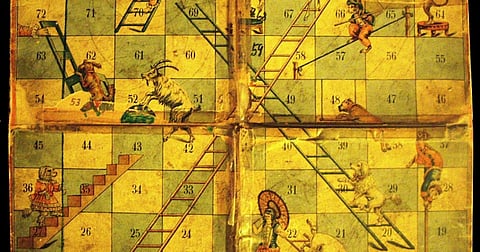

The game of Snakes & Ladders was created by the 13th century poet saint Gyandev. It originated in India as part of a family of dice board games that included gyan chaupar and pachisi. It had other local variations such as “Moksha Pat”, “Paramapada” “Sopanam” and other adaptations such as the Bengali “Golok Dham” and the Tibetan “Sa nam lam sha”.
The ladders in the game represented virtues and the snakes indicated vices. It was played with cowrie shells and dices.
In time, the game underwent several modifications, but its meaning remained the same, i.e. good deeds take people to heaven and evil to a cycle of re-births.
It reflected the common karmic themes of Hinduism, Buddhism and Jainism, but lost its spiritual significance on reaching the West where, retaining only its bare mechanics, it became Snakes and Ladders.
